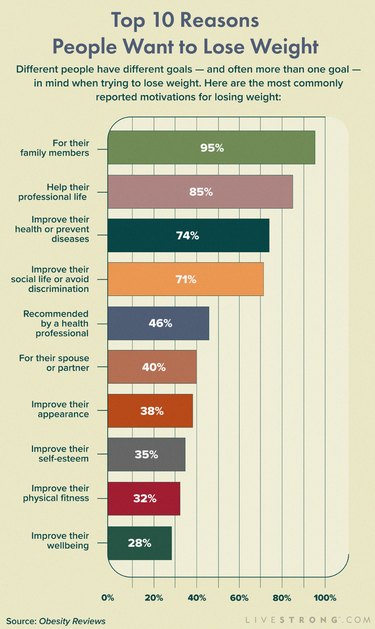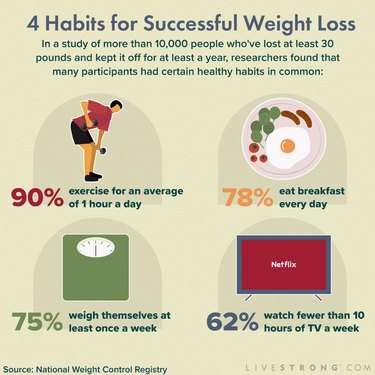
For better or worse, conversations about weight are extremely common in the United States. Questions abound — what's healthy, what isn't; what's "ideal," what's not. The topic is as fraught with feelings as it is importance.
Here's what isn't debatable: Almost half of people in the U.S. are actively trying to lose weight, according to the Centers for Disease Control and Prevention (CDC). Here's a closer look at who's trying to lose weight and how (and why) they're doing it.
Video of the Day
Video of the Day
Weight Loss Demographics
If you want to lose weight, one thing is for sure: You aren't alone. Globally, about 1 to 2 out of every 5 people are trying to shed pounds, and they're using everything from diets to exercise regimens to supplements to help them toward their goal.
Here's a snapshot of how many people around the world are trying to lose weight.
Weight Loss Prevalence Globally
As the percentage of people with overweight and obesity grows around the world, more people are reporting trying to lose weight, according to a January 2017 research review in Obesity Reviews.
Here's a breakdown of how many people say they're trying to lose weight, by region:
- 44% of people in North America
- 33.1% of people in East Asia and the Pacific
- 31.5% of people in Europe and Central Asia
- 26.8% of people in the Middle East and North Africa
- 25.6% of people in South Asia
- 20.6% of people in Latin America and the Caribbean
- 16.6% of people in Africa
Weight Loss Prevalence in the U.S.
From 2013 to 2016, nearly 1 in 2 adults in the U.S. tried to lose weight within the past 12 months, according to a July 2018 report from the CDC. Here's a closer look at the demographics:
Weight Loss Prevalence by Sex
A higher percentage of people assigned female at birth (AFAB) tried to lose weight than people assigned male at birth (AMAB).
- 56.4% of people AFAB
- 41.7% of people AMAB
Weight Loss Prevalence by Race
Non-Hispanic Asian adults were less likely to try to lose weight than people of other races in the U.S.
- 49.4% of non-Hispanic white adults
- 49.1% of Hispanic adults
- 48% of non-Hispanic Black adults
- 41.4% of non-Hispanic Asian adults
Weight Loss Prevalence by Age
Older adults were less likely to try to lose weight than middle-aged adults and younger adults.
- 49.7% of adults ages 20 to 39
- 52.4% of adults ages 40 to 59
- 42.7% of adults ages 60 and older
Weight Loss by Weight Status
People with obesity are more likely to try to lose weight than people of any other weight status.
- 66.7% of people with obesity tried to lose weight
- 49% of people with overweight tried to lose weight
- 26.5% of people who had underweight or a healthy weight tried to lose weight
Weight Loss Statistics for the U.K.
About half of people in the United Kingdom — 48 percent of Brits — have tried to lose weight in the past year, according to a 2016 report compiled by Mintel, a market research agency. A few more interesting U.K. stats:
- 57% of people AFAB tried to lose weight
- 64% of U.K. dieters said they try to lose weight all or most of the time
Weight Loss Stats for Australia
Nearly half of people in Australia — 46 percent of Aussies — have tried to lose weight in the past year, according to a 2017 survey by the Dietitians Association of Australia. About half (47 percent) of those who tried to lose weight spent money on a specific diet or program
Reasons for Weight Loss

People who are trying to lose weight report multiple reasons for doing so. Here are some of the most commonly reported motivations, according to the 2017 study in Obesity Reviews:
- 95% of people want to improve their wellbeing
- 84.6% of people wish to improve their physical fitness
- 73.9% of people would like to better their self-esteem
- 71.4% of people want to improve their appearance
- 46.2% of people want to lose weight for their spouse or partner
- 40% of people were told to lose weight by a health professional
- 37.8% of people wish to improve their social life or avoid discrimination
- 35.3% of people would like to improve their health or prevent diseases
- 32.3% of people say it will help their professional life
- 27.8% of people want to lose weight for their family members
Weight Loss Success Statistics
Can people successfully lose weight and keep it off? It's a decades-long (and sometimes contentious) question. What's more, researchers still don't have a definitive answer. Here are some weight-loss facts that fuel the debate.
Long-Term Weight Loss Success Rate
Many experts define "successful weight loss" as a 10 percent reduction in body weight, maintained for at least a year. (According to the CDC, if you have overweight, losing 5 to 10 percent of your total body weight can improve your blood pressure, cholesterol and blood sugar levels.)
That said, an August 2023 study in JAMA Network Open followed individuals with overweight and obesity and found that the annual probability of 5 percent or greater weight loss in these people was low (1 in 10). But chances for weight loss increased in patients with a higher initial BMI. The study concluded that more public health efforts should be aimed toward encouraging clinically meaningful weight loss for anyone with overweight.
Weight Regain Statistics
People who initially lose weight on a diet or exercise program often gain the weight back over time, according to a January 2018 research review in Medical Clinics of North America. Here's a closer look at the numbers:
- Within 2 years, people tend to regain more than half the weight they initially lost
- Within 5 years, people tend to regain about 80% of the weight they initially lost
Successful Weight-Loss Strategies

According to the National Weight Control Registry (NWCR) — the largest research study of people who've lost at least 30 pounds for at least a year — there are a few weight-loss strategies that are helpful in keeping the weight off:
- 90% of NWRC members exercise for an average of 1 hour a day
- 78% of NWRC members eat breakfast every day
- 75% of NWRC members weigh themselves at least once a week
- 62% of NWRC members watch fewer than 10 hours of TV a week
Weight Loss Industry Statistics
The U.S. weight-loss market reached a record worth of $78 billion in 2019, according to MarketResearch.com, a market research firm. While the COVID-19 pandemic caused its value to decline by 21 percent, the industry is still big business.
Here's a look at popular weight-loss strategies, diets, supplements, and more.
Popular Weight-Loss Methods
Some of the most common types of weight-loss strategies are dieting, exercising and/or eating healthy foods, according to the 2018 report from the CDC. Here's a breakdown of how people are trying to shed pounds:
- 62.9% of people exercised
- 52.9% of people ate less food
- 50.4% of people ate more fruits, vegetables and salads
- 44.7% of people drank a lot of water
- 42.4% of people ate less junk food or fast food
- 38.7% or people changed their eating habits
- 38.6% of people ate less sugar, candy or sweets
- 35.3% of people switched to foods with lower calories
- 30.4% of people ate fewer carbohydrates
- 29.2% of people ate less fat
- 16.4% of people skipped meals
Special Diets for Weight Loss
About 17.1 percent of U.S. adults over the age of 20 try to lose weight by following specific diets, according to a November 2020 report from the CDC. Here are some of the most popular types of diets:
- Weight-loss or low-calorie diet
- Diet for diabetes
- Low-carb diet
- Low-fat or low-cholesterol diet
Dietary Supplements for Weight Loss
About 15 percent of adults in the U.S. have used a weight-loss dietary supplement at least once in their lives, with about 21 percent of people AFAB using them and 10 percent of people AMAB, according to the National Institutes of Health Office of Dietary Supplements.
Americans spend about $2.1 billion a year on diet and weight-loss pills (including tablets, capsules and softgels).
Drugs and Medications for Weight Loss
There are four drugs that have been approved by the FDA for weight loss, including Contrave, Saxenda, Xenical and Qsymia, according to the Mayo Clinic. Many of them work by decreasing a person's appetite or increasing a person's satiety levels.
Surgery for Weight Loss
Weight-loss surgery — also known as metabolic and bariatric surgery — is a procedure that can help many people lose weight, either by making the stomach smaller or altering the small intestine to limit the number of calories a person can absorb. Here are a few facts about weight-loss surgery, according to the National Institute of Diabetes and Digestive and Kidney Diseases:
- People who have weight-loss surgery lose an average of 15 to 30% of their original weight
- Weight-loss surgery can cost between $15,000 and $25,000, depending on the type of procedure you have and your insurance plan (Medicare and Medicaid may help cover the costs)
- Obesity Reviews: "Prevalence of Personal Weight Control Attempts in Adults: a Systematic Review and Meta‐analysis"
- Centers for Disease Control and Prevention: "Attempts to Lose Weight Among Adults in the United States, 2013-2016"
- Mintel: "Brits Lose Count of Their Calories: Over a Third of Brits Don't Know How Many Calories They Consume on a Typical Day"
- "Dietitians Association of Australia: Aussies Wasting Time and Money on Pricey Fad Diets"
- Centers for Disease Control and Prevention: "What Is Healthy Weight Loss?"
- Medical Clinics of North America: "Maintenance of Lost Weight and Long-term Management of Obesity"
- The National Weight Control Registry: "NWCR Facts"
- MarketResearch.com: "The U.S. Weight Loss & Diet Control Market (16th Edition)"
- Centers for Disease Control and Prevention: "Special Diets Among Adults: United States, 2015-2018"
- National Institutes of Health Office of Dietary Supplements: "Dietary Supplements for Weight Loss"
- Mayo Clinic: "Weight Loss"
- National Institute of Diabetes and Digestive and Kidney Diseases: "Weight-loss (Bariatric) Surgery"
- JAMA Network Open: "Probability of 5% or Greater Weight Loss or BMI Reduction to Healthy Weight Among Adults With Overweight or Obesity"




